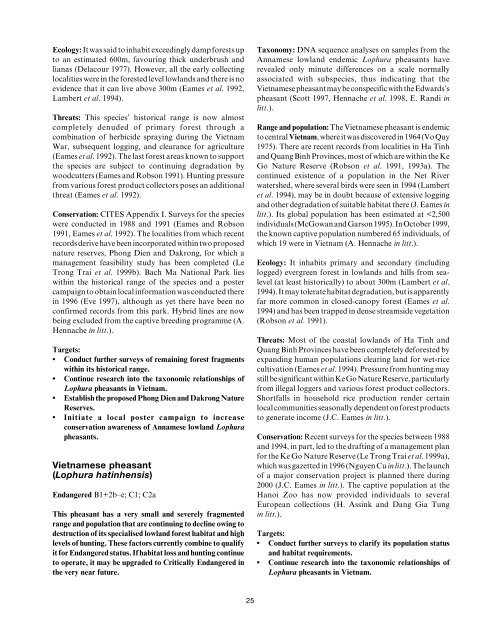Pheasants: Status Survey and Conservation Action Plan ... - IUCN
Pheasants: Status Survey and Conservation Action Plan ... - IUCN
Pheasants: Status Survey and Conservation Action Plan ... - IUCN
You also want an ePaper? Increase the reach of your titles
YUMPU automatically turns print PDFs into web optimized ePapers that Google loves.
Ecology: It was said to inhabit exceedingly damp forests up<br />
to an estimated 600m, favouring thick underbrush <strong>and</strong><br />
lianas (Delacour 1977). However, all the early collecting<br />
localities were in the forested level lowl<strong>and</strong>s <strong>and</strong> there is no<br />
evidence that it can live above 300m (Eames et al. 1992,<br />
Lambert et al. 1994).<br />
Threats: This species’ historical range is now almost<br />
completely denuded of primary forest through a<br />
combination of herbicide spraying during the Vietnam<br />
War, subsequent logging, <strong>and</strong> clearance for agriculture<br />
(Eames et al. 1992). The last forest areas known to support<br />
the species are subject to continuing degradation by<br />
woodcutters (Eames <strong>and</strong> Robson 1991). Hunting pressure<br />
from various forest product collectors poses an additional<br />
threat (Eames et al. 1992).<br />
<strong>Conservation</strong>: CITES Appendix I. <strong>Survey</strong>s for the species<br />
were conducted in 1988 <strong>and</strong> 1991 (Eames <strong>and</strong> Robson<br />
1991, Eames et al. 1992). The localities from which recent<br />
records derive have been incorporated within two proposed<br />
nature reserves, Phong Dien <strong>and</strong> Dakrong, for which a<br />
management feasibility study has been completed (Le<br />
Trong Trai et al. 1999b). Bach Ma National Park lies<br />
within the historical range of the species <strong>and</strong> a poster<br />
campaign to obtain local information was conducted there<br />
in 1996 (Eve 1997), although as yet there have been no<br />
confirmed records from this park. Hybrid lines are now<br />
being excluded from the captive breeding programme (A.<br />
Hennache in litt.).<br />
Targets:<br />
• Conduct further surveys of remaining forest fragments<br />
within its historical range.<br />
• Continue research into the taxonomic relationships of<br />
Lophura pheasants in Vietnam.<br />
• Establish the proposed Phong Dien <strong>and</strong> Dakrong Nature<br />
Reserves.<br />
• Initiate a local poster campaign to increase<br />
conservation awareness of Annamese lowl<strong>and</strong> Lophura<br />
pheasants.<br />
Vietnamese pheasant<br />
(Lophura hatinhensis)<br />
Endangered B1+2b–e; C1; C2a<br />
This pheasant has a very small <strong>and</strong> severely fragmented<br />
range <strong>and</strong> population that are continuing to decline owing to<br />
destruction of its specialised lowl<strong>and</strong> forest habitat <strong>and</strong> high<br />
levels of hunting. These factors currently combine to qualify<br />
it for Endangered status. If habitat loss <strong>and</strong> hunting continue<br />
to operate, it may be upgraded to Critically Endangered in<br />
the very near future.<br />
Taxonomy: DNA sequence analyses on samples from the<br />
Annamese lowl<strong>and</strong> endemic Lophura pheasants have<br />
revealed only minute differences on a scale normally<br />
associated with subspecies, thus indicating that the<br />
Vietnamese pheasant may be conspecific with the Edwards’s<br />
pheasant (Scott 1997, Hennache et al. 1998, E. R<strong>and</strong>i in<br />
litt.).<br />
Range <strong>and</strong> population: The Vietnamese pheasant is endemic<br />
to central Vietnam, where it was discovered in 1964 (Vo Quy<br />
1975). There are recent records from localities in Ha Tinh<br />
<strong>and</strong> Quang Binh Provinces, most of which are within the Ke<br />
Go Nature Reserve (Robson et al. 1991, 1993a). The<br />
continued existence of a population in the Net River<br />
watershed, where several birds were seen in 1994 (Lambert<br />
et al. 1994), may be in doubt because of extensive logging<br />
<strong>and</strong> other degradation of suitable habitat there (J. Eames in<br />
litt.). Its global population has been estimated at
















